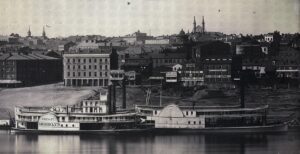Ohio Archives Month Spotlights: Inland Rivers Library, Cincinnati and Hamilton County Public Library
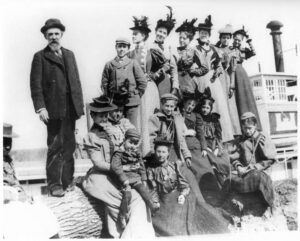
Caption: Group waiting to board a steamboat at Evansville, Indiana, 1895. Photograph link
The Society of Ohio Archivists Advocacy and Outreach Committee is happy to announce that we will be spotlighting archives around the state again this year to celebrate archives month throughout October 2023. Each of our archives spotlights will feature places that house materials related to the theme of the poster, Land, Water, & Air: Transportation in Ohio.
About the Inland Rivers Library
By A&O Committee member Erin Wilson, Ohio University Libraries
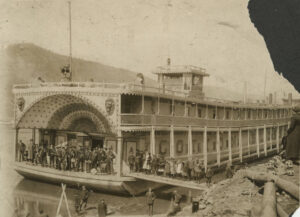
People aboard Cotton Blossom showboat on the banks of the Ohio River, circa 1908-1917. Photograph link
Have you ever wondered what life was like along the Ohio River when steamboats were the dominant form of transport? Whether you’re interested in river travel, trade, navigation, or the history of local river towns, the Inland Rivers Library is one of the largest and most comprehensive collections documenting use of the Ohio and Mississippi Rivers and their tributaries. Housed in the Genealogy and Local History Department of the Cincinnati and Hamilton County Public Library, the Inland Rivers collection includes materials dating back to the 1820s which present some of the earliest images and descriptions of the steamboat era and its Ohio locales.
Many rare and unique items from the Inland Rivers Library have been digitized and made available online in the Cincinnati Public Library’s Digital Collections.
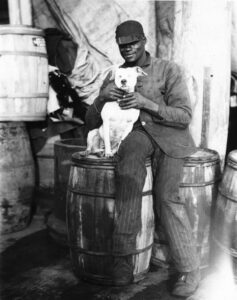
Crew member posing with dog aboard Queen City steamboat, 1906. The dog known as “Queen” was owned by the captain, John Sweeney. It reportedly bit everyone, including the Captain. Photograph link
They include published books, historical maps, beautifully preserved photo albums, and bills of lading with detailed cargo lists and route information. The collection also includes a selection of original handwritten manuscripts, such as the diary of Hannah S. Burk which recounts her travels on the Ohio River in 1849.
One of the most substantial resources within the Inland Rivers Library is the Inland Rivers Photograph Collection, containing more than 16,000 digitized images. This treasure trove of primarily black-and-white copy prints was originally curated by historian and former steamboat captain Frederick Way, Jr. The collection identifies more than 2,500 named boats that once traveled regional waterways. Other subjects of interest within the vast photo archive include river people, boat construction, ice scenes, and over 700 views of towns.
Interview with Christopher Smith
Christopher Smith is a Reference Librarian in the Genealogy and Local History Department at the Cincinnati and Hamilton County Public Library. He was kind enough to answer some questions about the Inland Rivers Library for the Advocacy and Outreach Committee (A&O).
A&O: What’s the history of the collection and how did it come to be a part of your archives?
Smith: The collection was gathered and collected by Frederick Way, Jr. of Marietta, Ohio. Frederick Way, Jr. (1901–1992) was a lifelong riverman and pilot of the Betsy Ann and other boats. In 1941, the Sons and Daughters of Pioneer Rivermen established a museum in Marietta, Ohio for their boat models, paintings, photographs, and steamboat relics, but found they didn’t have adequate storage facilities for all the associated books, pamphlets, ledgers, etc.
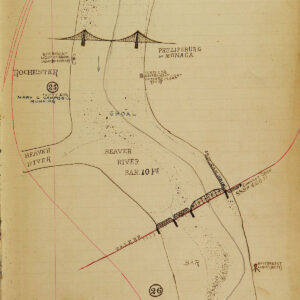
Detail from a hand drawn map of the Ohio River created by Captain Jesse P. Hughes in 1897. Photograph link
In 1956, the Sons and Daughters decided to deposit this documentary material with the Cincinnati and Hamilton County Public Library. In addition, Captain Frederick Way, Jr., a noted steamboat pilot and river historian, donated his personal collection of river materials to the Library. These gifts—combined with river holdings already in our collection—became the foundation for what has since become one of the major resources for information dealing with the commercial and navigational use of the Ohio and Mississippi Rivers and their tributaries.
A&O: What kind of materials are in the collection?
Smith: The majority of the Inland Rivers Collection is paper-based. Boat logs, bills of lading, letters to and from boat captains and owners, general correspondence between companies in the field, river maps of all kinds, photographs of the boats and of the rivers (plus cities along their paths), river-related scrapbooks, reel-to-reel tape recordings, VHS tape recordings, and 45 RPM and 33 1/3 RPM vinyl LP records of calliope recordings and other river related sounds.
Many of the materials date back to before the American Civil War. The collection also contains actual objects from the boats, such as bells, advertising signs, placards from the side of boats, including boat names such as the Delta Queen. Several pieces of river related art such as paintings and drawings, dinner menus, and cruise brochures to name but a few of the materials held within this vast collection.
A&O: What are some highlights of the collection, such as rare items or those with a unique story?
Smith: One of the crown jewels in the Inland Rivers Library is the Cincinnati Panorama of 1848, an eight-plate panorama taken by photographers Charles Fontayne and William S. Porter, now considered one of the finest daguerreotypes of its kind. The dramatic view of Cincinnati is the earliest known photograph of the waterfront and the earliest photographic record of Western rivers steamboats with 32 identifiable riverboats in this photograph.
A&O: How is the collection utilized by researchers and the community?
Smith: The Inland Rivers Library collections are utilized by a cross-section of the community including scholars, researchers, genealogists, riverboat/river historians/enthusiasts, and the casual library user wishing to browse the thousands of photographs which are part of the collection. This is a dense collection of materials containing something for many in the broader community.
A&O: How can the collection be accessed in-person and online?
Smith: While a good deal of the collection is available on the Digital Library, the larger portion of the print collection must be viewed in-person in the Cincinnati Room on the 3rd Floor at the Main Library.
Ledgers, bills of lading, letters, postcards, steamboat ephemera, history of boats, the river and the people on the river are but some of the treasures found within this collection.
Learn more about the Inland Rivers Library at https://chpl.org/services/special-collections/inland-rivers-library-collection/.
All images courtesy of the Cincinnati and Hamilton County Public Library.
Last Updated on October 24, 2023 by Emily Gainer

